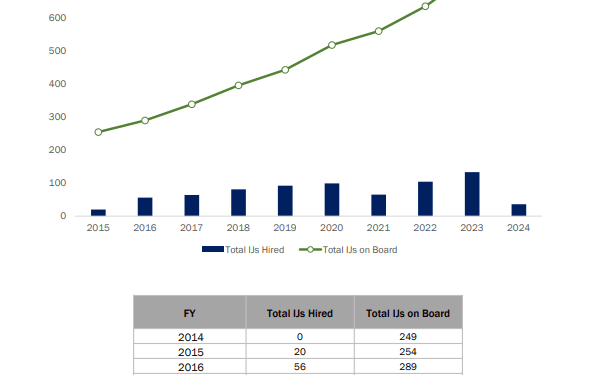McALLEN, Texas (Border Report) — The recent firing of 20 U.S. immigration judges will add to delays for an already overwhelmed immigration system, lawyers tell Border Report.
There are over 3.7 million backlogged immigration cases, according to Transactional Records Access Clearinghouse, and immigration lawyers say the removal of these judges come at a time when the system is suffering from the most cases ever in history.
“I’ve got master hearings — that are the initial hearings — that are not till like, two or three years from now and then after that, it’s going to be a few more years before you would have the final hearing individual so, I mean, you could be talking in some jurisdictions upwards of six, seven plus years for a case to be adjudicated,” William Brooks, a Houston immigration lawyer told Border Report on Monday. “So how things stand, the last thing you would want to do is eliminate judges.”
Thirteen immigration judges who were not yet sworn in were notified they had been dismissed on Friday along with five assistant chief immigration judges from the Executive Office for Immigration Review (EOIR), the Associated Press reports.
The cuts come as the new Trump administration is overhauling government and evaluating efficiency of offices.
There are about 735 immigration judges nationwide; that’s about 6,000 immigration cases per judge.
For the past decade, Congress has appropriated more money to hire more immigration judges — up to 100 per year — but many of the positions have not been filled despite record caseloads, U.S. Rep. Henry Cuellar, D-Texas, a senior member of the House Homeland Security Appropriations Committee has told Border report.

Brooks has been practicing immigration law since 2016 and he says he’s never seen cases so backed up.
“When you look at it just from a mathematical perspective, it’s, like, insane. It would take years, many years to just to dispense with the current cases we have now, and cases are actually being added every day, as notices to appear get filed by the DHS. So it’s only going to continue to grow,” he said. “So the last thing, in my opinion, you want to do is be letting go of judges, because that’s just going to increase the backlog.”
“I don’t know why, if the Trump administration wants to deport so many people that they would fire these judges,” said Claudia Galan, an immigration lawyer with offices in San Antonio and Edinburg, Texas. “This is just going to cause a bigger backlog.”
Galan told Border Report she has clients arrested since Trump took office on Jan. 20, and she says she is noticing Immigration and Customs Enforcement holding more in detention facilities, and bonds not issued for their release as they await their court hearings.
Galan says she has also noticed a change in administrative procedure whereby more legal motions are being filed, and less in-person proceedings held.
She says that can be a disadvantage for clients because that means less face-time in court with immigration judges and prosecutors, and fewer options for her as their advocate to speak about their case to others and to try to work out terms.
“There’s no open environment,” she said. “It’s like a wall going up that’s being enforced at all courts.”
She says different immigration courts in different jurisdictions hold proceedings in their own way.
An April 2023 report by the U.S. Government Accountability Office criticized the management of immigration cases as contributing to the record case backlog. This came after a similar report by the GAO in 2017.
“EOIR had not yet developed a strategic workforce plan or set workforce planning goals. In 2017, GAO recommended that EOIR develop and implement a strategic workforce plan that addresses the key principles of workforce planning — such as identifying critical skills, developing strategies to address skills gaps, and monitoring progress — to better position EOIR to address current and future staffing needs,” the 2023 GAO report found. “EOIR does not have a governance structure — consisting of assigned and documented roles and responsibilities — to guide its workforce planning efforts and hold leadership accountable for progress on workforce goals.”
In March, EOIR released a Strategic Management of Human Capital and Workforce Plan, which included a governance structure for workforce planning. EOIR also set performance appraisal programs for immigration judges, assistant chief immigration judges and appellate immigration judges, according to a GAO report.

In Fiscal Year 2024, immigration courts completed 914,812 cases — the most closures in a single fiscal year on record, TRAC reports. That was a 36% increase from the previous high of 674,848 cases closed in Fiscal 2023.
Still, backlogs continue to grow.
At the end of December, the last data available, TRAC reports there were 3.7 million pending cases and of those 1.7 million immigrants have filed forma asylum applications and are awaiting asylum hearings or decisions.
The most number of pending cases were in Miami, TRAC reports.
Most of the fired judges were in northern states, including Chicago and Pennsylvania, Galan said, with none in Texas.
Sandra Sanchez can be reached at [email protected].






